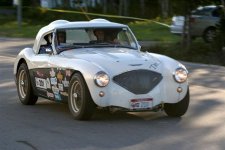wangdango
Jedi Hopeful
Offline
I have been racing a '56 100 LeMans w/the VSCCA for a bit over 16 years. Although the car is fast, I wonder its true horse power. It has: flat top pistons, .10 over bore, Carrillo rods, steel head, large D. Welch valves, flowed, ported head, Buick lifters, Lunatti cam, early 3000 flywheel, etc, 1 3/4 carbs. Welch told us they can get 200 horsepower on their race engines, is this possible? I would guess we have in the neighborhood of 160, 170 horsepower (can can "run" with XK 120's with no problems. Who out there has done what, and anyone have dyno #'s????? Always looking for ways to get a few more horses. Not interested in an alloy head, it wont be long till the VSCCA starts stopping there use (trust me, I know this..).

 Hi Guest!
Hi Guest!

 smilie in place of the real @
smilie in place of the real @
 Pretty Please - add it to our Events forum(s) and add to the calendar! >>
Pretty Please - add it to our Events forum(s) and add to the calendar! >> 





